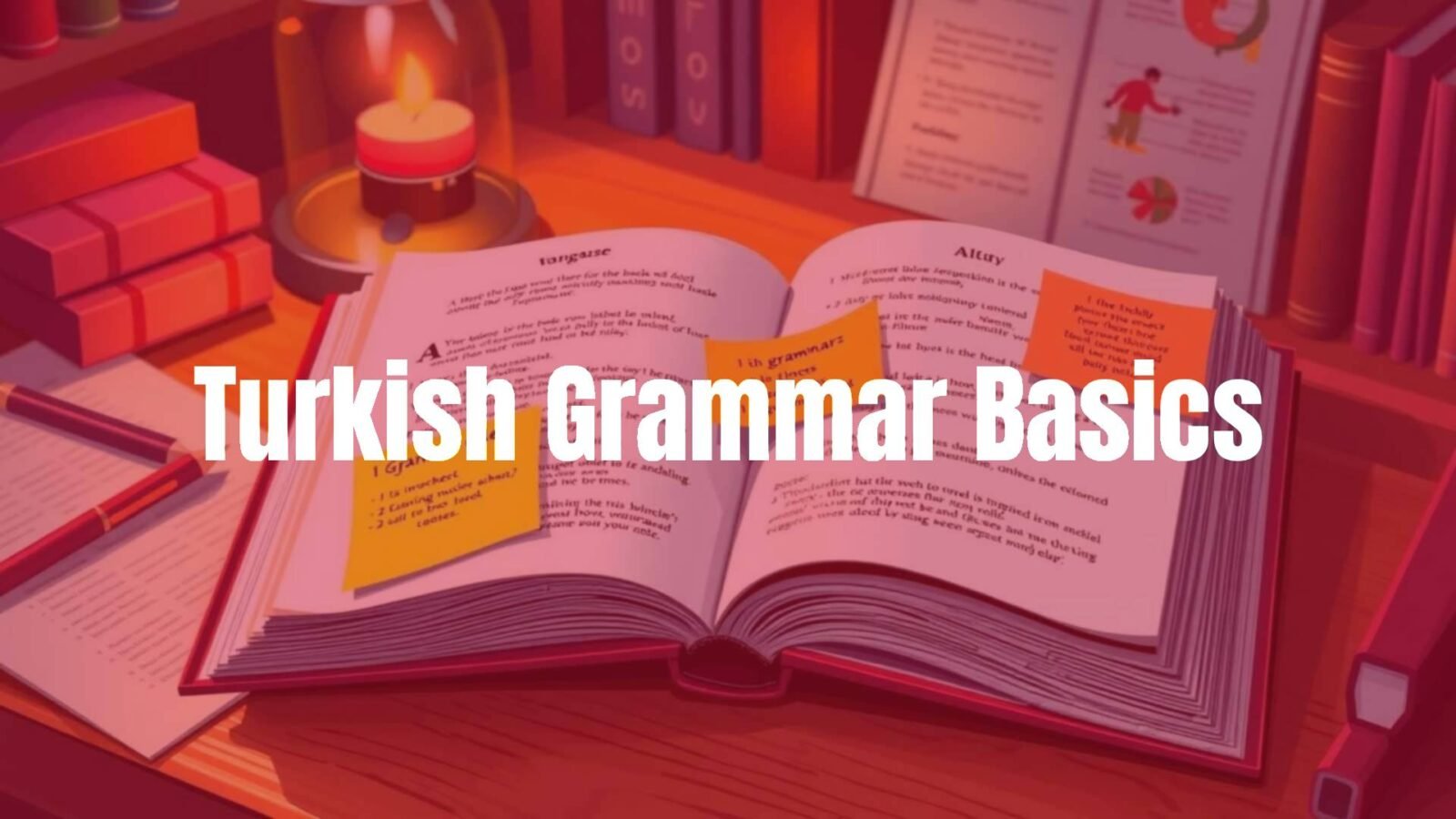Turkish grammar might look confusing at first, especially to English speakers. But there’s good news: Turkish grammar is very logical and follows clear patterns once you get the basics. Unlike English, which depends a lot on word order and prepositions, Turkish creates meaning mainly by adding suffixes to root words. This is called an agglutinative structure. Turkish also follows a sound rule called “vowel harmony,” which keeps words sounding smooth and unified. With Turkish, you’ll see how so much can be said using just one long word. Let’s take a look at the main ideas behind Turkish grammar in a simple way.
Some people think learning grammar is boring, but if you approach Turkish grammar with a little curiosity, you may find it interesting and even enjoyable. The rules are mostly regular, so once you learn a pattern, you can use it again and again, which can feel rewarding. Let’s break down the main parts that make Turkish grammar work.

Main Features of Turkish Grammar
At its foundation, Turkish grammar works a bit differently from most European languages. The main things to remember about Turkish are:
- It uses agglutination (adding suffixes to words).
- It usually follows Subject-Object-Verb (SOV) word order.
- It uses vowel harmony to keep suffixes and roots sounding smooth together.
These rules make Turkish very organized and easy to predict once you’re used to them. It’s like building something with blocks-each piece has its place and purpose.
What Makes Turkish Different?
Turkish stands out for several reasons. Here are some of the main differences:
- Turkish is agglutinative. Instead of extra words or changing word order, Turkish puts different suffixes on the end of a root word. For example, “from the houses” in English is just “evlerden” in Turkish (“ev” = house, “-ler” = plural, “-den” = from).
- There’s no grammatical gender-nouns are not “male” or “female.” The pronoun “o” means “he,” “she,” and “it.”
- Vowel harmony: Suffixes change form to match the vowels in the root word, which affects pronunciation and spelling.
SOV Word Order
In Turkish, sentences usually follow this order: Subject, Object, Verb. So, instead of “I am reading a book,” you’d say “Ben kitap okuyorum” (“I a book am reading”). The verb generally comes at the end. However, Turkish allows you to change word order to put focus on a certain word because the suffixes show the role of each word. For example, “Kitap okuyorum” highlights the “book,” while “Okuyorum kitabı” stresses the action of reading.
Agglutination and Suffixes
Agglutination is the key part of Turkish grammar. Turkish words grow longer and more detailed by adding one suffix after another to a root-for example, “ev” (house) becomes “evler” (houses), then “evlerden” (from the houses). Each suffix gives a new meaning. Suffixes also let you turn nouns into verbs or vice versa. This system means you can squeeze a lot of meaning into a single word.

Vowel Harmony
Vowel harmony keeps Turkish words sounding smooth. All the vowels within a word and its suffixes match each other as either “front” (e, i, ö, ü) or “back” (a, ı, o, u). Most suffixes will have two possible forms, one with a front vowel and one with a back vowel. For example, plural “-ler” is used with “ev” (evler – houses) and “-lar” with “araba” (arabalar – cars). Once you learn the pattern, it’s easy to choose the right suffix form.
Turkish Alphabet and Pronunciation
It’s important to start with the Turkish alphabet and its pronunciation rules. The Turkish alphabet is phonetic, so each letter usually has only one sound. This makes pronunciation much more straightforward than in English.
Differences from the English Alphabet
Turkish uses the Latin alphabet, just like English, but with 29 letters. It doesn’t include q, w, or x. It adds letters like ç, ğ, ı, ö, ş, and ü. Each letter usually represents only one sound, which makes it easier to read and speak Turkish words once you know the sounds.
Vowels and Consonants
Turkish vowels: a, e, ı, i, o, ö, u, ü. These are divided into:
| Front Vowels | Back Vowels |
|---|---|
| e, i, ö, ü | a, ı, o, u |
Consonants are mostly similar to English, but there are some differences:
- “c” is pronounced like “j” in jump.
- “ç” is like “ch” in church.
- “ğ” is silent-lengthens the previous vowel.
- “ş” is like “sh” in ship.
- “ı” is like the ‘a’ in “banana.”

Why Vowel Harmony Is Important
Vowel harmony affects almost every suffix. If the last vowel in the root is front, suffixes use their front vowel form-and so on. This rule helps you attach the correct suffix without a lot of memorization.
Nouns and Cases in Turkish
Turkish nouns get their role in the sentence from the suffixes attached to them, not word order or separate prepositions. Cases are suffixes that show meaning like “in,” “on,” “to,” or “from.”
How to Make Nouns Plural
Just add “-ler” (for front vowels) or “-lar” (for back vowels):
| Word | Plural Form |
|---|---|
| ev (house) | evler |
| araba (car) | arabalar |
If the noun comes after a number, you keep it singular, e.g., “beş elma” (five apples).
Noun Cases Table
| Case | Suffix | Meaning | Example |
|---|---|---|---|
| Nominative | none | subject, basic form | ev (house) |
| Accusative | -ı, -i, -u, -ü | definite direct object | evi (the house) |
| Dative | -e, -a | to, towards, for | eve (to the house) |
| Locative | -de, -da | in, on, at | evde (in/at the house) |
| Ablative | -den, -dan | from, out of | evden (from the house) |
| Genitive | -(n)in | of, ‘s | evin (of the house; house’s) |
Suffixes change according to vowel harmony and sometimes a buffer letter like “y” or “n” is needed if the noun ends in a vowel.

Pronouns and Personal Suffixes
Turkish uses pronouns, but often they’re not needed in sentences because the verb’s suffix already shows who’s doing the action.
Personal Pronouns
| English | Turkish |
|---|---|
| I | ben |
| you (singular) | sen |
| he/she/it | o |
| we | biz |
| you (plural or formal) | siz |
| they | onlar |
“O” is used for “he,” “she,” or “it.”
When Pronouns Are Used
Usually, you don’t need to say the pronoun because the verb shows it. For example, “çalışıyorum” means “I am working” (the “-yorum” tells you it’s “I”), so “ben” is not needed unless you want to focus on the subject for emphasis.
Possession Suffixes Table
| Meaning | Suffix | Example (ev = house) |
|---|---|---|
| my | -im | evim |
| your (singular) | -in | evin |
| his/her/its | -i | evi |
| our | -imiz | evimiz |
| your (plural) | -iniz | eviniz |
| their | -leri | evleri |
Vowel harmony changes the form of these suffixes as well.
Verb Basics: Conjugation, Tenses, and Negation
Turkish verbs get suffixes to show person, tense, and whether the sentence is negative or a question. Here are the main points:
Verb Conjugation in Different Tenses
| Tense | Suffix | Example (gelmek = to come) |
|---|---|---|
| Present Continuous | -(i)yor | geliyorum (I am coming) |
| Past Simple | -di, -dı, -du, -dü | geldim (I came) |
| Future | -(y)ecek, -(y)acak | geleceğim (I will come) |
The suffix changes based on vowel harmony and sometimes needs a buffer “y.” Personal endings are also added.
Other Tenses
Turkish has a reported past (-(i)miş), used when talking about something you did not see yourself, and an aorist tense (-(i)r) for habits or general truths (“gelir” – he/she comes, or might come).
Negating Verbs
To make a sentence negative, insert -me or -ma after the verb root. For example:
- gelmiyorum (I am not coming)
- gelmedim (I didn’t come)
- gelmeyeceğim (I won’t come)
“Değil” is used to make nouns and adjectives negative, e.g., “Evde değilim” (I’m not at home).

The Verb “to be”
There is no direct word for “am” or “is” in present tense Turkish. Suffixes attached to a word show “to be.” For example:
- öğrenciyim (I am a student)
- mühendissin (You are an engineer)
For sentences about the past or conditional, “olmak” or special endings show “to be.”
How to Ask Questions
To make a yes/no question, add the question particle “mi” after the verb (change form to mı, mu, mü by vowel harmony). For example:
- Geliyor mu? (Is he/she/it coming?)
- Geliyor musun? (Are you coming?)
This particle is always separate and matches the vowel harmony of what comes before it.
Suffixes and Buffer Letters
Suffixes are what give Turkish its meaning. But sometimes you can’t put two vowels next to each other, so buffer letters-like “y,” “n,” or “s”-are used for smooth pronunciation. For example:
- silgi + -i (accusative) → silgiyi
- elma + -ı (possessive) → elması
These buffers help keep words easy to say.
Main Suffix Types
- Derivational: Change the word’s class or create new words (yol=>yolcu=>yolculuk).
- Inflectional: Add grammatical meaning (case, tense, possession).
Vowel Harmony for Suffixes
- Two-way: Choose “e” or “a” (front or back vowel).
- Four-way: Choose “ı,” “i,” “u,” “ü” to match the root’s last vowel-see the table:
| Last vowel | Suffix vowel |
|---|---|
| a, ı | ı |
| e, i | i |
| o, u | u |
| ö, ü | ü |
Example: “evim” (my house), “okulun” (your school).
Adjectives and Adverbs
Adjectives come before the noun, just like English. They don’t change for plural or case. For example, “büyük ev” (big house), “büyük evler” (big houses), “büyük evde” (in the big house). Adjectives always stay the same.
Comparing in Turkish
- Positive: Adjective by itself (“güzel”-beautiful)
- Comparative: Add “daha” before (“daha güzel”-more beautiful, “Elma portakaldan daha tatlı”-Apple is sweeter than orange).
- Superlative: Add “en” before (“en hızlı”-the fastest)
Comparisons often use the ablative suffix on the compared noun.
How to Make Adverbs
Some adverbs are just adjectives in the right place (“iyi konuşuyor”-he speaks well). You can repeat words (“yavaş yavaş”-slowly) or use suffixes like “-ce” (“çocukça”-childishly) or “-erek” (“koşarak geldi”-he came running).
Conjunctions and Common Sentences
Conjunctions link sentences or ideas. Some common Turkish ones:
- “ve” = and
- “ama,” “fakat” = but
- “veya,” “ya da” = or
- “çünkü” = because
- “de” / “da” = also, too
- “ki” = that
Sentence Examples
Simple Sentences (SOV):
- “Ben elma yiyorum.” (I am eating an apple.)
- “Çocuk koştu.” (The child ran.)
- “O güzel.” (He/She/It is beautiful.)
Compound Sentences:
- “Geldin ve seni gördüm.” (You came and I saw you.)
- “Çok çalıştım ama başaramadım.” (I worked hard but I couldn’t succeed.)
- “Ya çay iç ya da kahve iç.” (Either drink tea or drink coffee.)
These examples show the SOV order and how conjunctions are used to join ideas in Turkish.
















Leave a comment